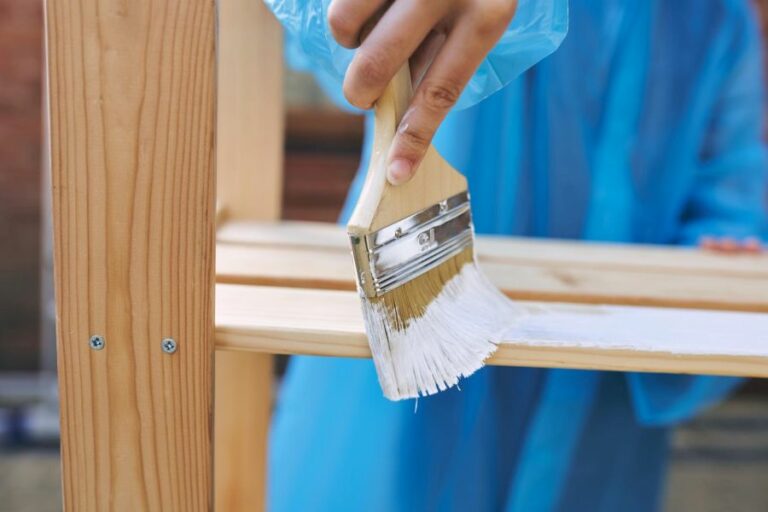Outdoor Rock Paint, 25 Things You Should Know
Are you tired of staring at your garden’s plain, lifeless rocks? It’s time to transform them into delightful, eye-catching pieces of art! We’ll introduce you to outdoor rock painting, a fun and engaging activity that brings new life into your garden space. We’ll share easy-to-follow techniques, handy tips, and exciting design ideas that inspire you to get creative.
Outdoor rock paint:
Outdoor rock painting is an enjoyable, inexpensive way to enhance your garden’s visual appeal. It involves selecting suitable rocks from landscaping suppliers or public beaches, using exterior acrylic paint, and applying clear sealants for protection. Preparing the rock canvas includes cleaning and priming, while the design stage encompasses base coating, detail work, layering, and blending. This versatile activity offers multiple options for artistic expression and can create personalized gifts or engaging projects for children.

Discover the vibrant world of outdoor rock painting! Unleash your creativity while connecting with nature using various techniques, materials, and inspiration. Follow our step-by-step guide to transform ordinary rocks into colorful masterpieces and curate your rock garden.
Contents
- 1 Exterior Rock Painting
- 2 What Type of Paint is Suitable for Outdoor Rocks?
- 3 What is the Process for Permanently Painting Rocks for Outdoor Use?
- 4 Which Type of Paint is Water-Resistant for Use on Rocks?
- 5 What Type of Paint Should I Utilize for Painting Rocks?
Exterior Rock Painting
• Introduction
Outdoor rock painting is an enjoyable and inexpensive way to enhance the visual appeal of your garden or yard.
Whether you want to provide a distinctive touch to your landscaping, create a personalized present for a loved one, or entertain children with a fun project, this versatile activity offers numerous options for artistic expression.
Due to their durability and easy maintenance, rocks are the perfect canvas for this creative form of outdoor decoration.
• Choosing the Right Materials
– Rocks
The first step in outdoor rock painting is selecting the right rocks to serve as your canvas. Avoid picking up any rocks from protected natural habitats or private property without permission. Instead, opt for rocks sourced from reputable landscaping suppliers, public beaches, or even from your own yard.
Smooth, flat rocks work best for creating detailed designs or accommodating larger text, while irregularly-shaped rocks can inspire interesting patterns or determine the final painted subject.
Choosing rocks of various shapes and sizes is a good idea to have a diverse range of canvases for your artistic ideas.
– Paints and Sealants
When it comes to choosing the appropriate paint for outdoor rock painting, it is crucial to select a paint that’s suitable for exterior use and will adhere well to the rock surface. Acrylic paint is an excellent choice, as it is durable, long-lasting, and provides vibrant colors.
You can also find acrylic paint specifically formulated for outdoor use, which will further ensure resilience against weather conditions.
In addition to acrylic paint, you will need a clear sealant to protect your painted rocks from the elements. Outdoor varnishes or sealants usually come in spray or brush-on varieties and can be found at hardware stores or craft supply shops.
• Preparing Your Canvas
Before you begin painting, it’s essential to properly clean and prepare your rocks. Wash them thoroughly with soap and water to remove any dirt, oils, or debris. If the rocks are particularly dirty, using a nylon brush can be helpful in removing stubborn grime.
Once clean, allow the rocks to dry completely before priming them. Applying a coat of exterior primer can significantly enhance the adhesion of paint to the rock surface, providing a smooth foundation for your design.
• Developing Your Design
There are countless design possibilities for outdoor rock painting, ranging from naturalistic landscapes to quirky and whimsical creatures. To determine your design, consider factors such as:
- The size and shape of your rock
- The location where the painted rock will be displayed
- Any personal preferences or interests
Additionally, you may wish to sketch or outline your chosen design using a pencil or chalk. This can help serve as a guide when you apply your paint, ensuring a more accurate and polished final product.
• Painting Techniques and Tips
– Base Coating
Start by applying a base coat of paint to your rock, which can be a single color, gradient, or textured background. This step provides a foundation for your design and enhances the overall appearance of your finished painted rock.
– Detail Work
Once your base coat has dried, begin working on the finer details of your design. Using a range of brush sizes, from small detailing brushes to broader strokes, is key for achieving a diverse range of textures and lines.
Moreover, don’t be afraid to use unconventional tools like toothpicks or cotton swabs for precise detailing or special effects.
– Layering and Blending
To achieve a more three-dimensional appearance in your design, consider utilizing techniques like layering and blending. Layering allows you to build up the depth by applying multiple coats of paint, while blending involves seamlessly merging adjacent colors to achieve smooth transitions between hues.
– Drying Time
Allow ample time for your painted rocks to dry between coats and before adding any sealants. Drying times can vary depending on several factors, including the thickness of your paint and the environmental conditions where you are working.
• Finishing Touches and Protection
Once your rock painting is complete and thoroughly dried, apply a clear sealant to protect your artwork from fading, chipping, or weather damage. Follow the manufacturer’s instructions for proper application and drying time, and be sure to select a sealant that is appropriate for outdoor use.
• Conclusion
Outdoor rock painting is a fantastic way to add a touch of creativity and personality to your garden while also providing numerous benefits, such as spending time outdoors, nurturing artistic skills, and building a sense of accomplishment.
By selecting the right materials, properly preparing your rocks, and experimenting with painting techniques, you will be well on your way to creating beautiful, one-of-a-kind masterpieces that will enhance your outdoor spaces for years to come.
What Type of Paint is Suitable for Outdoor Rocks?
Painting rocks has become a popular art form and a fun way to add some personality to your outdoor or garden space. Using the right kind of paint and technique is essential, especially given that outdoor rocks are exposed to various elements that can impact your artwork’s longevity.
• Acrylic Paint for Outdoor Rocks
Acrylic paint is perhaps the most commonly used and versatile type of paint for outdoor rocks. It is widely available and comes in a variety of colors and finishes to help you unleash your creativity.
– Pros
- Water-based: Acrylic paint is water-based, making it easy to clean up your brushes and tools after painting. Furthermore, since it is not toxic, it will not harm living creatures or plants in the vicinity.
- Quick drying: Acrylic paint dries fast, allowing you to work on different layers with relative ease and speed.
- Long-lasting: Known for its durability, acrylic paint adheres easily to rock surfaces and can withstand the elements quite well.
- UV-resistant: Many acrylic paints come with a UV-resistant formulation, offering additional protection from fading due to sunlight.
– Cons
- Waterproofing required: While acrylic paint has relatively good staying power, it is not completely waterproof. Sealing your work is essential to ensure it lasts through rain and dampness.
- Temperature sensitivity: Acrylic paint might become brittle or lose adherence in very cold conditions, a factor to consider in colder climates or seasons.
From personal experience, I recommend using high-quality, outdoor-specific acrylic paint for the best results on outdoor rocks. Brands such as Golden, Liquitex, and Arteza offer suitable options that are well-reviewed by artists and hobbyists alike.
• Patio Paint for Outdoor Rocks
Another popular choice for painting outdoor rocks is patio paint, specifically designed to hold up to the wear and tear of outdoor life.
– Pros
- Weatherproof: Patio paint is formulated to be weather-resistant and can withstand varying conditions, such as rain, snow, and sunlight.
- No sealing required: Unlike acrylic paint, patio paint does not require a sealer, which saves time and money.
- Adhesion: Patio paint is known for its adherence properties, designed to bond well with porous surfaces such as rocks and concrete.
– Cons
- Limited colors: Patio paint typically comes in a comparatively limited color range, which might restrict creative possibilities.
- Higher cost: The cost of patio paint may be slightly higher than acrylic paint, particularly since it is a specialized product.
Having worked with patio paint, I recommend DecoArt Patio Paint or FolkArt Outdoor Paint for their superior quality and excellent reviews.
• Spray Paint for Outdoor Rocks
Spray paint can be a convenient and fast option for covering a rock’s surface, but it requires some care and preparation to achieve the best results.
– Pros
- Even coverage: Spray paint offers excellent coverage and a smooth finish without the brush strokes visible with acrylic or patio paint.
- Speed: Spray painting is usually faster than painting with a brush, particularly when working on large surfaces.
– Cons
- Control: Achieving precision and control while using a spray paint can be more challenging than with a brush, especially for intricate designs.
- Ventilation: Spray paint emits strong fumes that can be harmful without proper ventilation. Therefore, it is crucial to use it in a well-ventilated area or wear a respirator.
For spray paint, I recommend using brands such as Rust-Oleum, Krylon, or Montana, which offer specialized formulas for outdoor use and have a wide range of colors.
• Preparation and Sealing Tips for Outdoor Rocks
Before painting your rocks, ensure they are clean and free of dirt or debris. Use a mild detergent and water to wash them and allow them to dry completely.
Once you have finished painting your rocks and the paint has dried, it’s essential to seal them for added protection from the elements. I recommend using a water-based polyurethane sealer or a clear acrylic spray sealer for the job.
Apply multiple thin coats, allowing each layer to dry before applying the next, and always follow the manufacturer’s instructions.
In conclusion, several paint options are suitable for outdoor rocks, with acrylic paint, patio paint, and spray paint being the most popular choices. Evaluate the pros and cons of each type and consider your specific artistic needs before making a decision.
Regardless of the paint type used, ensuring proper preparation and sealing will significantly extend the life of your artwork and add enjoyment to your outdoor space for years to come.
Type of Paint | Description | Pros | Cons |
|---|---|---|---|
Acrylic Paint | Water-based paint that dries quickly and is fade-resistant | Easy to use and clean up, dries quickly, wide color range | May require multiple coats, not as durable as some other options |
Outdoor Latex Paint | Exterior paint specifically designed for outdoor use, with added durability and weather resistance | Highly durable, weather resistant, adheres well | Requires longer drying time, harder to clean up |
Enamel Paint | Oil-based paint with a hard, glossy finish, often used on metal surfaces | Extremely durable, long-lasting, adheres well to surfaces | Long drying time, difficult clean up, strong odor |
Outdoor Craft Paint | Paint specifically designed for outdoor crafts and projects, often pre-sealed for added protection | Weather resistant, pre-sealed, easy to use | May not be as durable as other options, limited color range |
What is the Process for Permanently Painting Rocks for Outdoor Use?
Painting rocks outside is a popular and creative way to decorate your garden or landscaped area or even as a fun activity for children. However, choosing the right supplies and following the proper steps are crucial in ensuring that your painted rocks stay vibrant and withstand various weather conditions.
This comprehensive guide will provide you with step-by-step instructions on how to permanently paint rocks outside.
• Choosing the Right Supplies
– Selecting the Right Rocks
A vital first step is selecting the optimal rocks to paint. Smooth rocks with a flat surface work best, as they provide an ideal canvas for your designs.
River rocks are an excellent option due to their naturally smooth surfaces. Ensure that the rocks are free from dirt and debris and adequately sized for your desired purpose.
– Paint and Brushes
Acrylic paint is the best option when painting rocks for outdoor use. These paints are water-based, easy to clean up, and offer excellent durability when exposed to outdoor elements. Choose high-quality, weather-resistant acrylic paints that are specifically designed for outdoor use.
Select an assortment of paintbrushes suitable for your desired designs. Consider using a mix of flat, round, and fine-tipped brushes to create various strokes and detail work.
– Sealant
To preserve the longevity of your painted rocks, a sealant is necessary. Select a clear and weather-resistant sealant, preferably one with UV protection to prevent fading. Spray sealants typically yield a more consistent finish, but brush-on sealants are also effective.
• Preparing the Rocks
– Cleaning the Rocks
Before painting, ensure that your rocks are clean and free from dirt and dust. Start by rinsing them thoroughly with water, then use an old toothbrush or a soft-bristle cleaning brush to gently scrub away any remaining debris. Allow the rocks to dry completely before moving on to the next step.
– Priming the Rocks
Though not always necessary, priming the rocks with a coat of white acrylic paint or primer can enhance the vibrancy and durability of your final painting.
Priming provides a smooth and consistent base for your design, ensuring that the colors will appear true to their shades. Allow the primer to dry completely before proceeding.
• Painting Your Rocks
When painting your rocks, creativity is key. Whether you choose to paint intricate designs, animals, or even motivational words, the possibilities are endless. Here are a few tips to ensure your finished product is of the highest quality:
- Apply thin layers of paint, allowing each one to dry before applying the next. This technique will prevent the paint from peeling or cracking over time.
- Use high-quality paintbrushes to achieve smooth and precise strokes.
- If you make a mistake, gently dab it away using a damp cloth before it dries, then repaint as necessary once the area is dry.
- Allow your completed design to dry fully before handling or sealing.
• Sealing and Protecting the Painted Rocks
Once your painted rocks are completely dry, apply a clear, weather-resistant sealant to preserve and protect your artwork. Follow these steps for optimal results:
- Ensure the painted surface is clean and dry.
- In a well-ventilated area, carefully apply a thin, even coat of sealant to the entire painted rock, including the sides and bottom.
- Allow the sealant to dry completely, following the manufacturer’s recommended drying time.
- Apply a second coat of sealant for added durability, ensuring that it is also fully dry before placing your painted rock outside.
• Tips for Displaying Your Painted Rocks
Where and how you display your painted rocks is just as important as the painting process itself. Here are a few recommendations to ensure that your painted rocks make a lasting impression:
- Position the rocks in an area where they are not likely to be disturbed, such as in flower beds, landscape edging, or around paths.
- Avoid placing the rocks in direct contact with sprinklers or areas prone to pooling water to mitigate the risk of paint damage caused by consistently damp conditions.
- Remember that even with a high-quality sealant, exposure to direct sunlight may lead to fading over time. Consider rotating the placement of your painted rocks periodically or placing them in areas with partial shade to minimize the effects of UV exposure.
• Conclusion
By following the steps and recommendations provided in this comprehensive guide, you can create beautiful, permanently painted rocks for your outdoor space.
Remember to invest in high-quality supplies, follow proper preparation steps, and take care when displaying your artistic creations for a lasting impact. Happy painting!
Step | Instructions |
|---|---|
1 | Choose the right rocks. Select rocks that are smooth, clean, and have minimal crevices. |
2 | Clean the rocks. Remove dirt, dust, and debris by washing them with warm soapy water. Allow the rocks to dry completely before painting. |
3 | Select the right paint. Use acrylic paint or outdoor-specific paint to ensure the durability of your artwork. |
4 | Apply a primer (optional). A white acrylic primer can help make the colors more vibrant and improve the longevity of the paint. |
5 | Paint your design. Use brushes, sponges, stamps, or other tools to create your desired pattern or image on the rock. |
6 | Allow the paint to dry completely. Depending on the type and thickness of the paint, this may take a few hours to a full day. |
7 | Seal the rock. Apply a clear, weather-resistant sealer to protect the paint from fading, chipping, and other damage due to outdoor exposure. |
8 | Allow the sealer to dry. Follow the manufacturer’s instructions and let the sealer dry completely before placing the rock outside. |
Which Type of Paint is Water-Resistant for Use on Rocks?
Rocks are a popular medium for a variety of art projects, from simple rock painting to intricate mosaic designs. In order to ensure the longevity of your rock art, it is crucial to use the right type of paint.
Waterproof paint offers the durability needed to withstand the elements and keep your artwork looking fresh for years to come.
• Different Types of Waterproof Paints for Rocks
There are several kinds of waterproof paints that can be used on rocks. Some of the most popular options include:
– Acrylic Paint
Acrylic paint is a versatile and commonly used waterproof paint for rocks. It dries quickly, adheres well to most surfaces, and offers just the right amount of flexibility to prevent cracking over time. Acrylic paint is available in a wide variety of colors, allowing for endless creativity in your rock art projects.
– Oil-Based Paint
Oil-based paint is another option for waterproofing rocks. This type of paint is known for its durability and ability to withstand harsh weather conditions, making it an excellent choice for outdoor rock art.
The downside to oil-based paint is the long drying time required between coats, which can extend the overall time it takes to complete your project.
– Spray Paint
Spray paint is a convenient and fast-drying option for waterproof paint. Quality spray paint adheres well to rocks, and many brands offer specialty outdoor or waterproof varieties.
The main advantage of spray paint is the ease of application, making it an excellent choice for artists with little painting experience or limited time.
– Epoxy Paint
Epoxy paint is a durable waterproof paint option for rock art. It forms a hard, protective surface that can withstand harsh weather conditions and physical impacts. This makes epoxy paint a great choice for rocks that will be exposed to outdoor elements.
However, epoxy paint can be challenging to work with and may not be suitable for intricate designs or fine detail work.
• Factors to Consider When Choosing Waterproof Paint for Rocks
When selecting waterproof paint for your rock project, it’s essential to keep these factors in mind:
- UV Resistance: Choose a paint that offers UV resistance, as this will help prevent your artwork from fading over time due to sun exposure.
- Flexibility: A flexible paint will better adhere to the uneven surface of a rock and be less likely to crack or peel over time.
- Non-Toxic: If your rock art is placed outside and exposed to the elements, ensure the paint you choose is non-toxic and safe for the environment.
- Workability: Some waterproof paints can be difficult to work with, so consider your skill level and the intricacy of your design when selecting a paint.
- Drying Time: Depending on your schedule and the complexity of your project, you may want to choose a paint with a fast drying time to streamline your work.
• Tips for Painting Rocks with Waterproof Paint
For the best results when painting rocks, follow these tips:
- Clean the Surface: Thoroughly clean the rock’s surface with soap and water, ensuring there is no dirt or debris that could interfere with paint adhesion.
- Prime the Rock: Applying a primer will help the waterproof paint adhere better to the rock, creating a more durable finish. Choose a primer that is compatible with your chosen paint.
- Apply Multiple Coats: To ensure proper coverage and waterproofing, apply multiple thin coats of paint, allowing each coat to dry completely before applying the next one.
- Seal the Paint: Once the paint is fully dry, apply a clear sealant to protect the paint from UV damage and further waterproof the rock. This is especially important for rocks placed outdoors.
- Test the Paint’s Durability: Before exposing your painted rock to the elements, test its durability by leaving a sample piece outdoors for several weeks. This will give you an idea of how the paint might perform over time.
• Expert Recommendations for Waterproof Paint for Rocks
Based on my personal experience, some of the best waterproof paints for rocks are:
- Golden Artist Colors (GAC) Heavy Body Acrylics: This professional-grade acrylic paint offers excellent UV resistance, brilliant colors, and superior durability.
- Krylon Fusion All-in-One Spray Paint: This spray paint works well on a variety of surfaces, dries quickly, and offers excellent waterproofing for rocks.
- Rust-Oleum Universal All Surface Paint: Another spray paint option, Rust-Oleum boasts long-lasting durability and a paint-and-primer-in-one formula, simplifying your rock art project.
By considering the type of waterproof paint best suited for your rock art project and following the tips provided in this guide, you can create beautiful and durable artwork that will withstand the test of time.
What Type of Paint Should I Utilize for Painting Rocks?
Rock painting is a fun and creative hobby that people of all ages can enjoy. Whether you’re painting rocks for your garden, as an artistic outlet, or to hide and seek with others in your community, choosing the right paint for the job is crucial.
• Acrylic Paints: A Great Choice for Rock Painting
When it comes to painting rocks, acrylic paints are the most popular and widely recommended option. Acrylic paints are water-based and dry quickly, making them easy to work with. They come in a variety of vibrant colors, and when used properly, they can create beautiful and long-lasting designs on rocks.
– Pros
- Wide range of colors: Acrylic paints come in a vast array of colors, allowing you to create detailed and vibrant designs on your rocks.
- Quick-drying: These paints dry quickly, making it easy to layer different colors and add detail to your designs without having to wait too long between coats.
- Water-resistant: Once dry, acrylic paints are water-resistant, helping to protect your painted rocks from the elements.
– Cons
- Not as durable as oil paints: While acrylic paints are water-resistant, they are not as strong and durable as oil-based paints. However, you can increase their durability by sealing your finished rock with a clear sealant.
- Can be hard to control: Acrylic paint can be more challenging to work with than other types of paint because it dries so quickly. However, with practice, you can learn to control the paint and achieve the desired effects.
– Recommendations for Acrylic Paints
Based on my experience, the best acrylic paints for rock painting are:
- Liquitex BASICS Acrylic Paint: These paints offer smooth and creamy colors that are easy to apply and blend. They offer great coverage and come in a wide variety of colors.
- ARTEZA Outdoor Acrylic Paint: Specifically designed for outdoor use, these paints are perfect for rock painting enthusiasts who want to hide their rocks outside. They are weather-resistant and offer great coverage.
• Oil-Based Paints: A Durable Alternative to Acrylics
Oil-based paints are another option for rock painting enthusiasts. These paints are incredibly durable and can withstand the elements better than acrylic paints. However, they do come with some drawbacks.
– Pros
- Durability: Oil-based paints are incredibly durable and can withstand outdoor exposure better than acrylic paints, making them perfect for garden decorations or hiding painted rocks outside.
- Vibrant colors: Like acrylic paints, oil-based paints come in a wide range of colors, allowing you to create intricate designs on your rocks.
– Cons
- Long drying time: Oil-based paints can take days or even weeks to dry completely. This can make layering different colors and adding details to your designs more challenging.
- Toxic fumes: Oil-based paints release toxic fumes when drying, making them less suitable for indoor use or for those who are sensitive to strong smells.
– Recommendations for Oil-Based Paints
If you decide to use oil-based paints for your rock painting projects, I recommend the following:
- Winsor & Newton Winton Oil Color Paint: This paint offers a wide variety of colors and an excellent consistency for painting rocks. It also has a slower drying time, allowing you to work on your designs without feeling rushed.
- Weber Permalba Oil Paint: This professional-quality paint offers bright and vivid colors, and it’s highly durable, making it perfect for outdoor rock painting projects.
• Specialty Paints: Adding Texture and Effects to Your Designs
For those looking to add some flair to their rock painting projects, consider using specialty paints. These paints can help you create unique textures and effects on your rocks.
– Glitter Paints
Glitter paints add sparkle and shine to your rocks. Some popular glitter paint options for rock painting include DecoArt Glamour Dust Glitter Paint and FolkArt Extreme Glitter Acrylic Paint.
– Metallic Paints
Metallic paints give your designs a metallic sheen, creating eye-catching rocks that stand out. A great option for metallic paint is the DecoArt Dazzling Metallics Acrylic Paint.
– Glow-In-The-Dark Paints
Glow-in-the-dark paints are perfect for creating unique rocks that glow at night. The Crafts 4 All Glow In The Dark Acrylic Paints are a great option for this type of paint.
• Sealing Your Painted Rocks: The Final Step
No matter what type of paint you choose, it’s essential to seal your finished rock with a clear sealant. This will help protect your design from the elements and ensure it stays vibrant and beautiful for a long time. One highly recommended sealant is Mod Podge Clear Acrylic Sealer.
When you have the right paint and tools, rock painting can be a fun and rewarding hobby. By considering the pros and cons of different types of paint and following our recommendations, you’ll be on your way to creating stunning painted rocks that you can be proud of. Happy painting!







